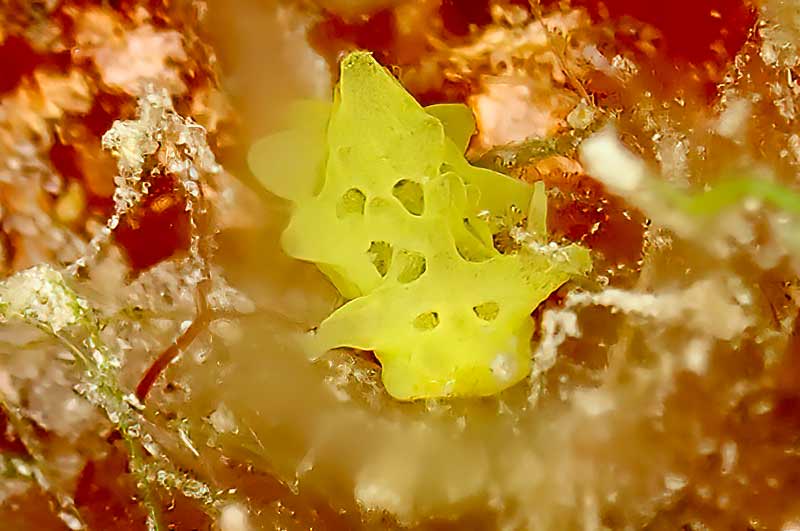A sighting of Aegires sublaevis, a rare nudibranch, was documented at the Cliff Dive Site in 2021.
In exciting news for the Bonaire National Marine Park (BNMP), a sighting of Aegires sublaevis, a rare nudibranch, was documented at the Cliff Dive Site last year. Incredibly, this nudibranch never before been documented anywhere in the Caribbean before this sighting on Bonaire, and this extraordinary discovery showcases the diversity–known and unknown–of the reefs protected in the island’s marine park since 1979. Bonaire continues to win scuba-diving awards worldwide for its beautiful macro-life and this discovery only further highlights why reef conservation is so vitally important.
What are nudibranchs?
Nudibranchs, a type of mollusk, fascinate both biologists and scuba divers worldwide. A diverse biological group, these tiny organisms are known for their elaborate colors, their ability to photosynthesize, and sometimes their cannibalistic behaviors, gaining them a passionate following from both underwater photographers and scientists alike. Forums around the world unite researchers, scientists, and photographers in their quest to discover and document these tiny creatures with big personalities.
The rare nudibranch, Aegires sublaevis.
It is through one such forum that researcher Dr. Leslie Wilk, co-author of Reef Creature Identification: Florida Caribbean Bahamas, tracked down author Tricia O’Malley, an amateur underwater photographer, as she had the only known photographs in the Caribbean of the rare nudibranch, Aegires sublaevis.
“I affectionately referred to the nudibranch as “Glow Cheese,” because I was unable to find the correct identification. Its brilliant yellow color and patchy skin made me think of a block of Swiss Cheese. I was delighted to discover it at the Cliff Dive Site – one of my favorite locations for macro life and night diving. I take joy in night diving because the reefs truly come alive in the dark.
“It is astounding to me, that after hundreds of dives at Bonaire, I still discover new and exciting finds on each dive. The Cliff Dive Site is particularly bountiful when it comes to finding nudibranchs, and I can’t tell you how excited I am to have had the opportunity to see such rare and unusual macro-life. I’m truly honored to live somewhere that declares its commitment to protecting the reefs. It just shows that there is so much more to learn about the delicate reef ecosystem and that The Netherlands should consider Bonaire’s reef to be a crown jewel to be preserved at all costs.” – Tricia O’Malley
Another rare nudibranch (previously undescribed) is observed, from the family Dorididae.
It was through her discussions with Dr. Wilk that Tricia learned that she had documented another rare nudibranch–also at Cliff–which has not yet been described or named. It is a member of the family Dorididae. This tiny sea creature will now join the ranks of one of Bonaire’s newest marine animals.
In his research, Dr. Wilk also discovered other rare nudibranchs found on Bonaire by local naturalist, Ellen Muller. These nudibranchs are Trapania bonellenae, as well as an undescribed species of Cerberilla. These finds only serve to further highlight the extraordinary diversity of Bonaire’s reefs.
These rare nudibranch observations, along with other extraordinary sightings of marine creatures, give credence to Bonaire’s reef system as being diverse and remarkable.
Dr. Wilk explained that recent finds show that Bonaire, in particular, has several rare and undescribed species. The rarest is Trapania bonellenae, an endemic slug named partly after the island and partly after the local resident who discovered it. Aegires sublaevis, a species rarely seen anywhere, was recently photographed on Bonaire. Undescribed species of Spurilla, Cerberilla, and Dorididae have been found in Bonaire’s shallows, but nowhere else. There is also a rare color form of Elysia flava.
Dr. Wilks is of the opinion that such extraordinary aspects of Bonaire’s sea slug fauna extend to other marine taxa. For example, the preliminary results of a 2020 survey of Bonaire’s marine biodiversity, funded by Naturalis Biodiversity Center and the ANEMOON Foundation, discovered the existence of at least seven species of invertebrates that are new to science, that proves that ongoing research is revealing Bonaire’s marine life to be more diverse and remarkable than ever expected. The discovery of the Aegires sublaevis will be published in the upcoming field guide, Tropical West Atlantic Sea Slugs.
Why are these sightings so important?
These observations provide exciting new insight into Bonaire’s coral reef ecosystems and the opportunity for new marine life discoveries. It is vitally important to protect an environment where new species are still being discovered. As development on Bonaire increases, so does the pressure on the dynamic reef ecosystem, and it will be crucial that conservation leads Bonaire’s future.
Report your sightings.
These nudibranch sightings have been officially registered. Species reports by local communities and visiting tourists are invaluable for nature conservation efforts to help increase public awareness and overall species protection.
You can report your nature sightings and upload any images to the website www.Observation.org or download the free apps (iPhone (iObs) & Android (ObsMapp)). You may also send your information to research@DCNAnature.org for support with getting your data stored.













